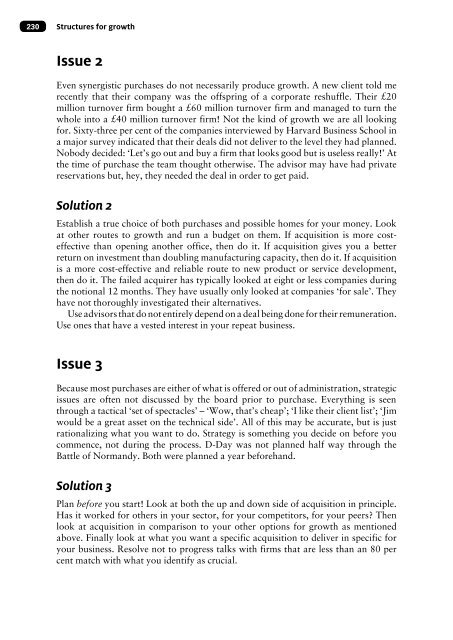The growing business handbook : inspiration and advice ... - Sparkler
The growing business handbook : inspiration and advice ... - Sparkler
The growing business handbook : inspiration and advice ... - Sparkler
Create successful ePaper yourself
Turn your PDF publications into a flip-book with our unique Google optimized e-Paper software.
230 Structures for growth<br />
Issue 2<br />
Even synergistic purchases do not necessarily produce growth. A new client told me<br />
recently that their company was the offspring of a corporate reshuffle. <strong>The</strong>ir £20<br />
million turnover firm bought a £60 million turnover firm <strong>and</strong> managed to turn the<br />
whole into a £40 million turnover firm! Not the kind of growth we are all looking<br />
for. Sixty-three per cent of the companies interviewed by Harvard Business School in<br />
a major survey indicated that their deals did not deliver to the level they had planned.<br />
Nobody decided: ‘Let’s go out <strong>and</strong> buy a firm that looks good but is useless really!’ At<br />
the time of purchase the team thought otherwise. <strong>The</strong> advisor may have had private<br />
reservations but, hey, they needed the deal in order to get paid.<br />
Solution 2<br />
Establish a true choice of both purchases <strong>and</strong> possible homes for your money. Look<br />
at other routes to growth <strong>and</strong> run a budget on them. If acquisition is more costeffective<br />
than opening another office, then do it. If acquisition gives you a better<br />
return on investment than doubling manufacturing capacity, then do it. If acquisition<br />
is a more cost-effective <strong>and</strong> reliable route to new product or service development,<br />
then do it. <strong>The</strong> failed acquirer has typically looked at eight or less companies during<br />
the notional 12 months. <strong>The</strong>y have usually only looked at companies ‘for sale’. <strong>The</strong>y<br />
have not thoroughly investigated their alternatives.<br />
Use advisors that do not entirely depend on a deal being done for their remuneration.<br />
Use ones that have a vested interest in your repeat <strong>business</strong>.<br />
Issue 3<br />
Because most purchases are either of what is offered or out of administration, strategic<br />
issues are often not discussed by the board prior to purchase. Everything is seen<br />
through a tactical ‘set of spectacles’ – ‘Wow, that’s cheap’; ‘I like their client list’; ‘Jim<br />
would be a great asset on the technical side’. All of this may be accurate, but is just<br />
rationalizing what you want to do. Strategy is something you decide on before you<br />
commence, not during the process. D-Day was not planned half way through the<br />
Battle of Norm<strong>and</strong>y. Both were planned a year beforeh<strong>and</strong>.<br />
Solution 3<br />
Plan before you start! Look at both the up <strong>and</strong> down side of acquisition in principle.<br />
Has it worked for others in your sector, for your competitors, for your peers? <strong>The</strong>n<br />
look at acquisition in comparison to your other options for growth as mentioned<br />
above. Finally look at what you want a specific acquisition to deliver in specific for<br />
your <strong>business</strong>. Resolve not to progress talks with firms that are less than an 80 per<br />
cent match with what you identify as crucial.








